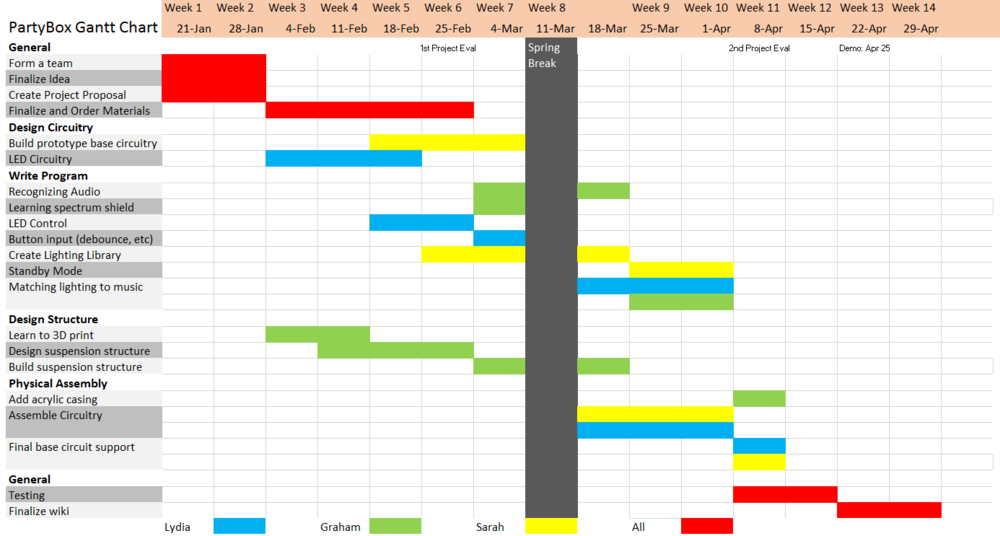Difference between revisions of "PartyBox"
Lydia.reader (talk | contribs) |
|||
| Line 23: | Line 23: | ||
* Learning how to use addressable LED strips | * Learning how to use addressable LED strips | ||
* Processing the data from the spectrum shield | * Processing the data from the spectrum shield | ||
| + | * Making sure all LEDs are bright and have enough power | ||
==Budget== | ==Budget== | ||
Revision as of 02:17, 28 February 2017
Creators: Sarah Chen, Lydia Reader, Graham Rubin, Nathan Schmetter (TA)
Overview
PartyBox is an easily portable and self-contained three dimensional cube of LEDs that creates a visual display in time to live music, so you can have a fun party anytime or anywhere. It's the perfect size for any tabletop, approximately 4.5" in each direction. The LEDs are dynamic and change color to provide an aesthetically pleasing light show that follows along to the rhythm and pitch of the music. The pattern of the LED light show can be changed with the push of a button. A library of different patterns will be created and the user can cycle through these patterns by pushing a small button on the cube. There is an additional standby mode in which the LEDs will provide a slow gradient change of color in the absence of music.
PartyBox will be made up of 3m of an addressable RGB LED strip with a total 180 LEDs. The LEDs will be on the outside of the five surfaces of the cube (not including the bottom surface). A small microphone will be built into the box that will read the analog sound signal. A spectrum shield will be attached to an Arduino to process the sound signal. The Arduino will detect the occurrences of bass frequencies to clock the tempo of the music.The Arduino will also take incremental measurements of volume. The lights will be in an animated display in which the coloring of the LEDs is directed by the measured tempo, and the brightness directed by the measured volume. A collection of light patterns will be pre-made, and the user will be able to go to a new pattern by pressing a push button. Additionally, if the Arduino does not detect volume and rhythm for a pre-determined amount of time, it will automatically go into standby mode -- a simple, slow-changing color gradient.
Objectives
- Lighting of LEDs in time with music
- Varied library of complex visual displays rather than just flashing LEDs
- Functioning standby mode and transition between standby and music
- Ability to change the pattern of the light through the push of a button
- Easily portable and self-contained
Challenges
- Getting Arduino to discern rhythm and volume of live music.
- Creating a substantial enough library of animations to keep users' interest in the cube
- Using a push button as an input
- Creating a 3D structure to suspend LEDs without interfering with their visibility.
- Avoiding overheating of LEDs and the subsequent safety hazard while being able to light all LEDs at once.
- Learning to read and convert sound to a digital signal.
- Making the Arduino able to tell the difference between background noise and music
- Learning how to use addressable LED strips
- Processing the data from the spectrum shield
- Making sure all LEDs are bright and have enough power
Budget
| Item | Quantity | Price | Shipping | Link | Notes |
| Arduino | 1 | 0 | 0 | Provided by lab | |
| RGB LED Strip 1m | 3 | 15.95 | 9.71 | link | |
| 20 Gauge Wire | Provided by lab | ||||
| Audio technica ATR 4650 Microphone | 1 | 6.99 | 0 | link | |
| Acrylic sheet (12"x24"x0.125") | 1 | 8.06 | 6.79 | link | Will check if availabe at Dick Blick on Delmar; may not need this item depending on finalized design |
| Plastic Super Glue | 2 | 2.99 | 0 | link | Will be shipped with acrylic sheet |
| Arduino push button | 1 | 5.29 | 0 | link | |
| Arduino Spectrum Shield | 1 | 24.95 | 2.99 | link | |
| Arduino Shield Stacking Headers | 1 | 1.95 | 0 | link | Shipped with spectrum shield |
| Power Source | 1 | TBD | Voltage and current needed will be determined during testing so exact power source needed will be determined at a later time | ||
| Total: | $120.56 |
